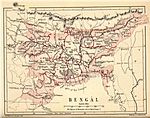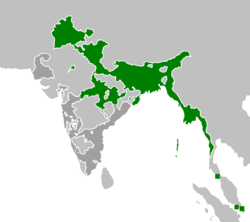
Back حكم البنغال Arabic বেংগল প্ৰেচিডেঞ্চি Assamese বেঙ্গল প্রেসিডেন্সি Bengali/Bangla Presidència de Bengala Catalan Bengalen (Präsidentschaft) German Presidencia de Bengala Spanish Présidence du Bengale French बंगाल प्रेसीडेंसी Hindi Kepresidenan Benggala ID Presidenza del Bengala Italian
This article needs additional citations for verification. (September 2022) |
| History of Bengal |
|---|
 |
| History of West Bengal |
|---|
 |
| History of Bangladesh |
|---|
 |
|
|
| History of India |
|---|
 |
| Timeline |
| Part of a series on |
| Bengalis |
|---|
 |
The Bengal Presidency (Bengali: বেঙ্গল প্রেসিডেন্সি), officially the Presidency of Fort William in Bengal, later the Bengal Province, was the largest of all three presidencies of British India during Company rule and later a province of India.[5] At the height of its territorial jurisdiction, it covered large parts of what is now South Asia and Southeast Asia. Bengal proper covered the ethno-linguistic region of Bengal (present-day Bangladesh and the Indian state of West Bengal). Calcutta, the city which grew around Fort William, was the capital of the Bengal Presidency. For many years, the governor of Bengal was concurrently the governor-general of India and Calcutta was the capital of India until 1911.
The Bengal Presidency emerged from trading posts established in the Bengal province during the reign of Emperor Jahangir in 1612. The East India Company (HEIC), a British monopoly with a Royal Charter, competed with other European companies to gain influence in Bengal. In 1757 and 1764, the Company defeated the Nawab of Bengal, who acted on Mughal sovereignty, at the Battle of Plassey and the Battle of Buxar, and Bengal came under British influence. In 1765, Emperor Shah Alam II granted revenue rights over Bengal to the Company and the judicial rights in 1793. After this, the Bengal province was later merged with the Presidency of Fort William but under the suzerainty of the Emperor until 1835.[6]
In 1836, the upper territories of the Bengal Presidency were organised into the Agra Division or North-Western Provinces and administered by a lieutenant-governor within the Presidency. The lower territories were organised into the Bengal Division and put in charge of lieutenant-governor as well in 1853. The office of the governor of the Presidency was abolished and the Presidency existed as only a nominal entity under the dual government of the two lieutenant-governors at Agra and Calcutta. The 1887, the Agra Division was separated from the Presidency and merged with the Oudh province, ending the dual government. In 1912, the governor was restored. In the early 20th century, Bengal emerged as a hotbed of the Indian independence movement and the Bengali Renaissance,[7] as well as education, politics, law, science and the arts. It was home to the largest city in India and the second-largest city in the British Empire.[8]
At its territorial height in the mid nineteenth century, the Bengal Presidency extended from the Khyber Pass to Singapore.[9][10][11] In 1853, the Punjab was separated from the Presidency into a new province. In 1861, the Saugor and Nerbudda Territories of the North-Western Provinces (which was then a division of the Bengal Presidency) were separated from the Presidency and merged with the Nagpur Province to created the Central Provinces. In 1871, Ajmer and Merwara which were also administered as a part of the North-Western Provinces were separated from the Presidency to form the Ajmer-Merwara Province. In 1874, Assam was separated from Bengal.[11] In 1862, Burma became a separate province. The Straits Settlements became a Crown Colony in 1867.[12] In 1877, the North Western Provinces were finally separated from Bengal and merged with Oudh. Thus, by 1877, the Bengal Presidency included only modern-day Bihar, Jharkhand, Orissa and Bengal. In 1905, the first partition of Bengal resulted in the short-lived province of Eastern Bengal and Assam which existed alongside the Bengal Presidency. In 1912, the province was merged back with the Bengal Presidency while Bihar and Orissa became a separate province.
In 1862, the Bengal Legislative Council became the first legislature in British India with native representation, after a petition from the British Indian Association of Calcutta.[13][14] As part of efforts towards home rule, the Government of India Act 1935 created a bicameral legislature, with the Bengal Legislative Assembly becoming the largest provincial assembly in India in 1937. The office of the Prime Minister of Bengal was established as part of growing provincial autonomy. After the 1946 election, rising Hindu-Muslim divisions across India forced the Bengal Assembly to decide on partition, despite calls for a United Bengal. The Partition of British India in 1947 resulted in the second partition of Bengal on religious grounds into East Bengal (present-day Bangladesh) and West Bengal.
- ^ Government of India Act 1833 (38). Parliament of the United Kingdom of Great Britain and Ireland. 28 August 1833.
- ^ Government of India Act 1935 (PDF) (269—2). Parliament of the United Kingdom of Great Britain and Northern Ireland. 2 August 1935. p. 166.
- ^ "Battle of Plassey | National Army Museum". Nam.ac.uk.
- ^ Visaria, Leela; Visaria, Praveen (1983), "Population (1757–1947)", in Dharma Kumar (ed.), The Cambridge Economic History of India: Volume 2, C.1757-c.1970. Appendix Table 5.2.
- ^ "Economic History of Bengal Presidency" (PDF). International Growth Centre.
- ^ The Bengalis. p. 143.
- ^ Dutta, Sutapa (2022). "Colonial textbooks and national consciousness in British India". History of Education. 51 (6): 827–845. doi:10.1080/0046760X.2022.2050304. S2CID 248603349.
- ^ Marshall, P. J. (2 August 2001). The Cambridge Illustrated History of the British Empire. Cambridge University Press. ISBN 9780521002547.
- ^ Llewellyn-Jones, Rosie (2023). Empire Building: The Construction of British India, 1690–1860. Hurst Publishers. ISBN 978-1-80526-026-4. Retrieved 3 August 2023.
- ^ Tan Tai Yong. "A Tale of Two Cities: Singapore and Kolkata Past and Present" (PDF). National University of Singapore. p. 3.
- ^ a b "The Commonwealth and Dhaka". 15 September 2023.
- ^ "The Straits Settlements becomes a residency - Singapore History". Eresources.nlb.gov.sg. Retrieved 30 March 2020.
- ^ "English Releases".
- ^ "Bengal Legislative Council". Banglapedia.


